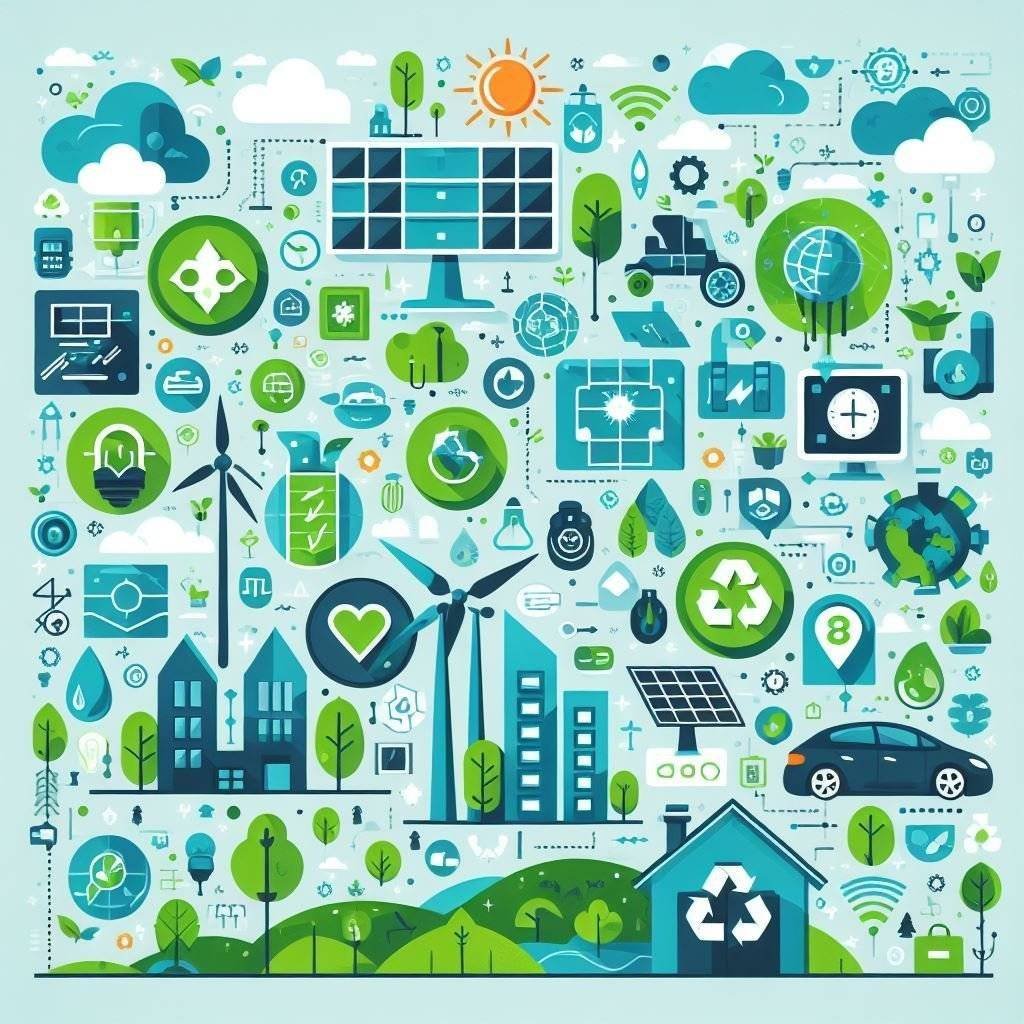Green Tech Innovations Chart
| Category | Technology | Advancements | Applications |
|---|---|---|---|
| Renewable Energy | Solar Power | High-efficiency panels, bifacial panels, perovskite cells | Residential & commercial installations, solar farms, building integration |
| Renewable Energy | Wind Energy | Larger & efficient turbines, offshore & floating wind farms | Large-scale wind farms, community projects, residential turbines |
| Renewable Energy | Hydropower | Low-impact systems (micro-hydro, run-of-the-river) | Rural electrification, small communities, existing water infrastructure |
| Energy Storage | Lithium-Ion Batteries | Improved energy density, lifespan, faster charging | Electric vehicles, grid storage, portable electronics |
| Energy Storage | Solid-State Batteries | Increased safety, higher energy density, faster charging | Next-gen EVs, consumer electronics, renewable energy storage |
| Energy Storage | Flow Batteries | Scalable storage for large amounts of energy | Grid storage, renewable energy integration, backup power systems |
| Sustainable Transportation | Electric Vehicles (EVs) | Extended range, reduced charging times, increased affordability | Personal vehicles, public transportation (buses), commercial fleets (trucks) |
| Sustainable Transportation | Hydrogen Fuel Cells | Improved efficiency, reduced costs of hydrogen production & fuel cell systems | Heavy-duty transportation (trucks, buses), industrial machinery, backup power |
| Sustainable Transportation | Shared Mobility Solutions | Development of ride-sharing platforms, e-scooters, e-bikes | Urban transportation, first/last-mile connectivity, sustainable commuting |
| Green Building Technologies | Energy-Efficient Buildings | Smart building management systems, advanced insulation materials, efficient HVAC systems | Residential & commercial buildings, retrofits, new construction |
| Green Building Technologies | Sustainable Building Materials | Materials with lower environmental impact (CLT, recycled steel, eco-concrete) | Sustainable construction projects, green building certifications, urban development |
| Smart Grids & Energy Management | Smart Grids | Integration of advanced sensors, automation, communication technologies | Enhanced grid reliability, renewable energy integration, demand response programs |
| Smart Grids & Energy Management | Home Energy Management Systems (HEMS) | Smart thermostats, energy monitoring devices, AI-driven platforms | Residential energy savings, increased renewable energy adoption, improved home comfort |
| Circular Economy & Waste Management | Recycling Technologies | Improved sorting technologies, chemical recycling processes, biodegradable materials | Municipal waste management, industrial recycling, consumer goods packaging |
| Circular Economy & Waste Management | Waste-to-Energy | Technologies converting waste materials into energy (anaerobic digestion, gasification) | Municipal solid waste management, industrial waste treatment, renewable energy production |
| Circular Economy & Waste Management | Circular Product Design | Designing products for longevity, reparability, recyclability | Consumer electronics, fashion industry, industrial products |
| Agricultural Innovations | Precision Agriculture | Use of IoT sensors, drones, AI for optimized crop management | Crop monitoring, soil health management, efficient resource use |
| Agricultural Innovations | Vertical Farming | Indoor farming systems using hydroponics or aeroponics | Urban agriculture, local food production, reduced transportation emissions |
| Agricultural Innovations | Sustainable Aquaculture | Closed-loop systems & sustainable feed alternatives | Fish farming, shellfish cultivation, integrated multi-trophic aquaculture (IMTA) |
Table of Contents
Environmental crises loom large, casting a long shadow over our planet. Climate change, resource depletion and pollution are serious threats to our future. However, amidst these challenges, a ray of hope has emerged – green technology or “green technology.” This rapidly evolving field offers a diverse array of innovative solutions designed to promote sustainability and mitigate environmental damage. This analysis explores the most promising advances in green technology, exploring their potential to create a cleaner, more sustainable future.
The Power of Renewable Energy
Renewable energy sources, using nature’s energy, are at the heart of green technology. These alternatives to fossil fuels provide a cleaner, more sustainable path to energy production. Let’s delve deeper into the roles of some major participants.
- Solar Power: The undisputed champion of renewable energy, solar technology is experiencing a renaissance. Progress includes:
- High-Efficiency Panels: New generations of panels, such as bifacial designs that capture sunlight from both sides, and perovskite cells boasting high efficiency and low cost, are pushing the boundaries of solar energy.
- Diverse Applications: Solar installations are no longer limited to large-scale farms. Residential and commercial rooftops are increasingly equipped with solar panels, while building-integrated photovoltaics (BIPV) integrate solar technology seamlessly into building materials.
- Wind Power: Wind turbines are becoming more powerful and efficient. Larger turbines capture more wind energy, while offshore and floating wind farms tap previously inaccessible wind resources.
- Hydropower: While large-scale dams may have environmental drawbacks, advances in low-impact hydro systems offer a sustainable solution. Micro-hydro and run-of-the-river turbines generate clean energy for rural communities and integrate well with existing water infrastructure.
Optimizing Data Management: Advanced Storage Solutions
Renewable energy sources, despite their abundance, often face the challenge of intermittency. The sun doesn’t always shine, and the wind doesn’t always blow. To truly exploit their potential, efficient energy storage solutions are crucial:
- Lithium-Ion Batteries: The workhorse of the energy storage world, lithium-ion batteries are seeing improvements in energy density, lifespan and charging speed. Lithium ion batteries offer a versatile solution, powering electric vehicles, storing energy for the grid, and fueling portable electronics.
- Solid-State Batteries: Solid-state batteries offer considerable advantages over lithium-ion batteries, poised to revolutionize energy storage. They boast enhanced safety, high energy density and fast charging times, making them suitable for next-generation electric vehicles, consumer electronics and renewable energy integration.
- Flow Batteries: Offering a large-scale solution, flow batteries can store large amounts of energy for extended periods of time with minimal degradation. They provide grid storage solutions, facilitate renewable energy integration and serve as reliable backup power systems.
Transportation Revolution: Shifting Gears Towards Sustainability
Transportation is a leading culprit in greenhouse gas emissions. Green technology offers a versatile approach to cleaning our streets:
- Electric Vehicles (EVs): EVs are no longer a novelty. Advances in battery technology have increased their range, reduced charging times and made them more affordable. Private vehicles, public transportation systems including electric buses, and commercial fleets including electric trucks are all transitioning to a cleaner future.
- Hydrogen Fuel Cells: For long-distance transportation needs, hydrogen fuel cells offer a promising solution. A key area of research is optimizing hydrogen production and fuel cell technology to achieve greater efficiency and lower cost. Heavy-duty vehicles such as trucks and buses, industrial machinery and even backup power systems could potentially benefit from hydrogen fuel cell technology.
- Shared Mobility: Reducing the need for private car ownership is another key strategy for sustainable transportation. Ride-sharing platforms, e-scooters and e-bikes offer convenient and eco-friendly ways to get around, especially in urban areas.
Building Green: Constructing a Sustainable Future
While the built environment has a major impact, sustainable design offers ways to mitigate its negative effects. Advances in green technology are revolutionizing how we design and construct buildings:
- Energy-Efficient Buildings: Smart building management systems optimize energy use, advanced insulation materials reduce heat loss, and energy-efficient HVAC systems keep buildings comfortable without wasting energy. These advances are being applied to both new construction projects and retrofits of existing structures.
- Sustainable Building Materials: Building materials themselves are undergoing a green transformation. Cross-laminated timber (CLT) offers a strong, renewable alternative to concrete, while recycled steel and eco-friendly concrete alternatives reduce the environmental footprint of construction. These sustainable materials are increasingly being adopted in green building projects, contributing to certifications such as LEED and BREEAM.
Smart Grids and Energy Management: Optimizing the Flow
The way we distribute and manage energy is critical to maximizing efficiency and integrating renewable energy sources. Green technologies provide solutions to address these challenges:
- Smart Grids: These intelligent networks use advanced sensors, automation and communication technologies to optimize power distribution. Smart grids increase grid reliability, continuously integrate renewable energy sources, and facilitate demand response programs, where customers can adjust their energy use based on real-time electricity prices.
- Home Energy Management Systems (HEMS): Empowering individuals, HEMS integrates smart thermostats, energy monitoring devices and AI-powered platforms to optimize energy use within the home. These systems promote residential energy savings, encourage adoption of renewable energy sources, and improve overall home comfort.
Closing the Loop: Waste Not, Want Not
Waste management has traditionally been a linear process – we receive, we use and we throw away. Green technology is promoting a more circular approach:
- Recycling Technologies: Sorting technologies are becoming more sophisticated, allowing better material separation. Chemical recycling processes are breaking down complex materials for recycling, and advances in biodegradable materials are reducing plastic waste. These advances contribute to improved municipal waste management, industrial recycling practices, and environmentally friendly consumer product packaging.
- Waste-to-Energy: By converting waste into a valuable resource, technologies such as anaerobic digestion and gasification convert waste materials into usable energy. Municipal solid waste management, industrial waste treatment, and even renewable energy production can benefit from these waste-to-energy solutions.
- Circular Product Design: A fundamental change in product design is crucial for a truly circular economy. Green technology promotes designing products with longevity, replaceability and recyclability in mind. This approach reduces waste, increases resource efficiency and can be applied to a variety of fields, from consumer electronics and fashion to industrial products.
Cultivating a Sustainable Future: Innovations in Agriculture
Feeding a growing population with traditional farming practices puts enormous pressure on our resources. Green Tech provides solutions for a more sustainable food system:
- Precision Agriculture:Using the power of the Internet of Things (IoT), drones and artificial intelligence, precision agriculture optimizes crop management. By collecting real-time data on soil conditions and weather patterns, farmers can make informed decisions about water use, reduce chemical inputs and improve crop yields.
- Vertical Farming: This innovative method uses indoor farming systems that employ hydroponics or aeroponics to grow food with minimal land and water use. Vertical farming provides solutions for urban agriculture, allowing for local food production and reducing transport emissions associated with traditional farming methods.
- Sustainable Aquaculture:Traditional fish farming can have environmental drawbacks. Green tech promotes closed-loop systems that minimize waste and pollution. Sustainable food alternatives are being developed to reduce reliance on fish meal, which is a major contributor to overfishing. These advances pave the way for responsible fish and shellfish farming, and even integrated multi-trophic aquaculture (IMTA) systems that combine different species for a more balanced and sustainable approach.
Conclusion: A Symphony of Green Technologies
Green technology is not a single innovation, but a vibrant symphony of interconnected solutions. By harnessing the power of renewable energy, developing efficient storage solutions and promoting sustainable practices across sectors, we can create a cleaner, more sustainable future. To address the pressing environmental challenges of our age, widespread adoption and integration of green technologies is essential. Imagine a world powered by the sun and wind, where buildings are energy-efficient and waste is transformed into a valuable resource. This vision is within reach, but requires concerted efforts by individuals, businesses and policymakers. By adopting green technology, we can ensure a healthy planet for generations to come.



